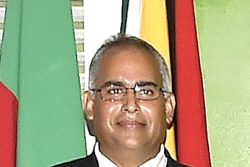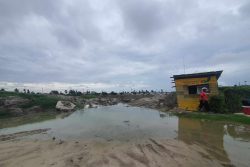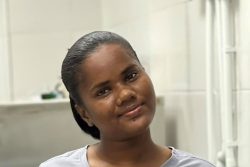Dear Editor,
My lengthy paper submitted last year to the National Assembly of the Guyana Parliament, entitled: “GuySuCo- the course it should follow to escape the syndrome of declining productivity and profitability; and the critical role it can and should play in the political, economic and social development of Guyana”, was read by Dr. Dhanpaul Narine, Dr. Carl Niamatali, Flattie Singh, and by persons, who are concerned about GuySuCo. I wish to explain or reiterate three things:
(1) Firstly, that the model I am advocating in my paper rests solidly on the socialist principle of Land to the Tiller, as enshrined in the Constitution. I referred to this principle in the paper as “Peasantization”. Peasantization, I explained, would eventually and systematically lead to ownership.
(2) Secondly, and more importantly, my paper is calling for a “Transformation of the Economy”. Implicit to and implied in this transformation is the need for a “Green Revolution”, on which I will shortly amplify.
(3) Thirdly, funding for this Revolution will take the form of selling of National Agriculture Development Bonds in and outside Guyana (also mentioned in my paper), the details of which can be better worked out by the Ministry of Finance and the Bank of Guyana. I would be willing to amplify on this subject and participate in any discussion and implementation.
In a world where the demand for food doubles every twenty-five years, I contend that Guyana must be the only country that de-emphasizes agriculture as a means of feeding its people, and launching its industrial development via an agro-based take-off. Several acts of past and present governments support this contention, the latest being President David Granger’s cancellation of leases granted to several West Coast Berbice rice farmers which was subsequently ruled unconstitutional by Chief Justice Roxane George.
Incidentally, the ruling was made with reference to another section of the Constitution, and no mention was made by her nor by PPP’s Attorney General, Anil Nandlall, to the socialist-oriented “Land to the Tiller” clause which was specifically enshrined in the constitution by Forbes Burnham, himself. Burnham was smart enough to realize, far ahead of his time, that any development of Guyana had to rest on ameliorating the antagonistic relations existing in the means of production – which I refer to in my paper as characterized by two major forms of alienation:
(1) The alienation of labour from the production or any decision-making process, and
(2) The alienation of the industry from the international pricing mechanism.
Development economists all agree that a country must produce and trade in the goods and services in which it enjoys a comparative advantage. In layman’s language, this simply means a person must work in the field in which he is talented, gifted or trained.
Our comparative advantage lies in agriculture. The problem with agriculture in Guyana is that production basically never advanced from primary to secondary and tertiary levels. We produced rice, sugar and milk, but we imported rice pudding. We produce sugar, milk and cocoa, but imported Ovaltine, Milo and chocolate. We produce millions of cubic feet of lumber, but not one tooth-pick. We remain, like our former absentee plantation owners, an enclave economy producing primarily for export, and consuming primarily – imports. Thus, with little or no value added to it, we created for ourselves a serious disadvantage in international trade, being fatally susceptible to fluctuations in international pricing mechanisms and terms of trade. We have been content to live in such economic squalor forever.
For, whereas agriculture should have been the engine of growth to launch our industrial development, it remained in an infancy stage. And, after 50 years of independence, according to Cassius in Shakespeare’s Julius Caesar: “The fault, dear Brutus, is not in our stars, (or colonial inheritance) But in ourselves, that we are underlings.” Yes, we are a lazy people, dependent on handouts obtained from government jobs, foreign relatives, or through banditry, white-collar crimes, and multifarious devious means. We do not have the drive, the motivation, the stamina for massive development programs that Developed Countries embarked upon when they were in their infancy stages. (I marvel sometimes at the hundred-year-old subway system of New York City, the Verrazano Bridge… not at the engineering marvels themselves, but at the determination of the people to develop their country.)
The term “Green Revolution” was first used in 1968 by US Agency for International Development (USAID), noting and advocating the advancement of new technologies in the field of agriculture, establishing strong agri-supportive institutions, and restructuring social and educational institutions, all with the primarily objective of self-sufficiency in food production, particularly in developing countries, and to help advance their economic development. Since then, many heavily populated countries have successfully carried out this revolution, including several in Africa. One person who became famous for his involvement in the Green Revolution is the scientist Norman Borlaug. In the 1940s, Norman Borlaug developed a strain of wheat that could resist diseases, was short, which reduced damage by wind, and could produce large seed heads and high yields. This strain of wheat was introduced in Mexico, India, Brazil and even several African countries.
In and within twenty years the production of wheat in Mexico tripled to the point where it became a net exporter of wheat. In 1961, India, on the brink of mass famine invited Norman Borlaug to advise them on wheat production. This year India forecasts the harvesting of 92 million tonnes of wheat. Currently, Brazil consumes 12 million tons of wheat a year, but produces only seven million, with the balance imported from Russia and Argentina. In Africa, it is noted that wheat production is at only 10 to 25 percent of its potential, but it is noted that African countries, spending $12B annually to import wheat, can easily grow more to limit hunger. For his work in developing high-yield crops and for helping prevent starvation in many developing countries, Norman Borlaug was awarded the Nobel Peace Prize. I am not by any means suggesting that GuySuCo should plunge into wheat, only that, as a grain with a growing world demand, it is worth exploring, even as ethanol production is being explored.
I have, in my paper, suggested a dozen other viable crops in addition to meat and dairy production. My list is not exhaustive. Other non-traditional crops such as maize, potatoes, soybeans, barley, peas, lentils, chick peas (channa) and a host of others are very viable possibilities.
Sincerely,
Gokarran Sukhdeo
Former Economist,
Ministry of Agriculture, Guyana






